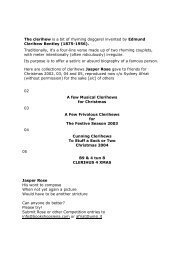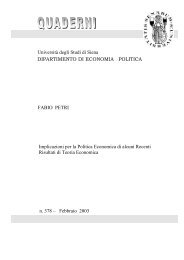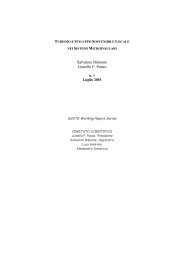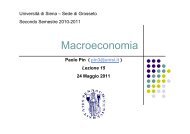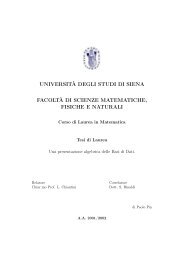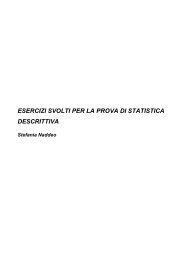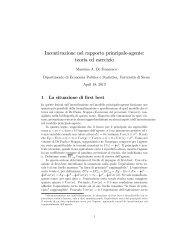Appunti delle lezioni di istituzioni di matematica attuariale per le ...
Appunti delle lezioni di istituzioni di matematica attuariale per le ...
Appunti delle lezioni di istituzioni di matematica attuariale per le ...
Create successful ePaper yourself
Turn your PDF publications into a flip-book with our unique Google optimized e-Paper software.
e ricordando che la riserva tVx è non negativa, si ottiene che<br />
∆ retr<br />
t = tVx ρt , (200)<br />
cioè che l’uti<strong>le</strong> da retrocedere è l’interesse al tasso ρt della riserva <strong>matematica</strong> al tempo t.<br />
L’ultima uguaglianza della (199) mostra che 1 + ρt = [1 + max (βIt , i)]/(1 + i). Il fattore<br />
1/(1 + i) è presente <strong>per</strong>ché il tasso ρt, in base al qua<strong>le</strong> viene calcolato l’uti<strong>le</strong> da retrocedere<br />
<strong>per</strong> l’anno [t − 1, t], viene applicato alla riserva <strong>di</strong> fine anno e non a quella <strong>di</strong> inizio anno. A<br />
meno <strong>di</strong> quel fattore, il tasso <strong>di</strong> rivalutazione è il maggiore fra il ren<strong>di</strong>mento attribuito e il<br />
tasso tecnico.<br />
L’uti<strong>le</strong> trattenuto<br />
∆ tratt<br />
t<br />
si può invece esprimere nella forma<br />
= ∆t − ∆ retr<br />
t<br />
∆ tratt<br />
t<br />
= tVx<br />
It − i<br />
1 + i<br />
It − max(βIt , i)<br />
= tVx<br />
1 + i<br />
− ρt<br />
oppure, ricordando <strong>le</strong> proprietà degli o<strong>per</strong>atori max e min 18 , nella forma<br />
∆ tratt<br />
t<br />
= tVx<br />
<br />
(201)<br />
min[(1 − β)It , It − i]<br />
. (202)<br />
1 + i<br />
Quin<strong>di</strong>, sempre a meno del fattore 1/(1 + i), l’assicuratore si tiene (in senso algebrico) il<br />
minore fra il ren<strong>di</strong>mento trattenuto e lo spread fra il ren<strong>di</strong>mento It e il tasso tecnico.<br />
Nella figura 2 sono mostrate alcune <strong>del<strong>le</strong></strong> grandezze coinvolte nella costruzione dell’uti<strong>le</strong><br />
retrocesso e trattenuto, in funzione del ren<strong>di</strong>mento It. In riferimento a quella figura, è<br />
imme<strong>di</strong>ato osservare che:<br />
• Se It < i l’assicuratore non è riuscito a rivalutare gli attivi in maniera sufficiente e il<br />
surplus è negativo:<br />
It − i<br />
∆t = tVx < 0 .<br />
1 + i<br />
Poiché β > 0, si ha che βIt − i < It − i < 0 e quin<strong>di</strong> il tasso <strong>di</strong> rivalutazione è nullo<br />
<br />
βIt − i<br />
ρt = max , 0 = 0 ,<br />
1 + i<br />
l’uti<strong>le</strong> retrocesso è nullo<br />
∆ retr<br />
t<br />
= tVx ρt = 0<br />
e l’uti<strong>le</strong> trattenuto è negativo, coincide con il surplus ed è, in valore assoluto, l’entità<br />
dell’integrazione che l’assicuratore deve o<strong>per</strong>are <strong>per</strong> coprire la riserva in t:<br />
∆ tratt<br />
t<br />
18 Gli o<strong>per</strong>atori max e min godono <strong>del<strong>le</strong></strong> proprietà:<br />
= ∆t = tVx<br />
It − i<br />
1 + i<br />
< 0 .<br />
max(−a , −b) = − min(a , b) , <strong>per</strong> ogni coppia <strong>di</strong> numeri reali a e b;<br />
min(−a , −b) = − max(a , b) , <strong>per</strong> ogni coppia <strong>di</strong> numeri reali a e b;<br />
max(a , b) + c = max(a + c , b + c) , <strong>per</strong> ogni terna <strong>di</strong> numeri reali a, b e c;<br />
min(a , b) + c = min(a + c , b + c) , <strong>per</strong> ogni terna <strong>di</strong> numeri reali a, b e c;<br />
c max(a , b) = max(c a , c b) , <strong>per</strong> ogni terna <strong>di</strong> numeri reali a, b e c, con c ≥ 0;<br />
c min(a , b) = min(c a , c b) , <strong>per</strong> ogni terna <strong>di</strong> numeri reali a, b e c, con c ≥ 0.<br />
c○ C. Pacati 2005, <strong>Appunti</strong> IMAAV, sezione 6 (v. 26/12/2005) pag. 41



